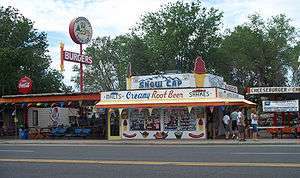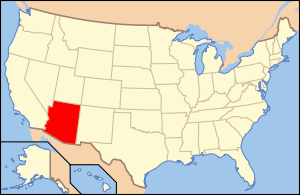Seligman Commercial Historic District
|
Seligman Commercial Historic District | |
|
The historic Seligman Sundries building located in the district | |
  | |
| Location | Roughly bounded by First and Lamport Sts, and Picacho and Railroad Aves., Seligman, Arizona |
|---|---|
| Coordinates | 35°19′35″N 112°52′27″W / 35.32639°N 112.87417°WCoordinates: 35°19′35″N 112°52′27″W / 35.32639°N 112.87417°W |
| Area | 18 acres (7.3 ha) |
| Built | ca. 1903 |
| Architectural style | Early Commercial, Prairie School, etc. |
| NRHP Reference # | 04000511[1] |
| Added to NRHP | February 1, 2005 |
The Seligman Commercial Historic District is a historic district in central Seligman, Yavapai County, northwestern Arizona.[2]
The historic district is along historic Route 66 in town, which was designated a historic highway by the state of Arizona in 1978.[3] The Seligman Commercial Historic District was placed on the National Register of Historic Places in 2005.[1]
History


The region was in the longtime homeland of the Havasupai people, who had a settlement in the present day Seligman area.
Originally Seligman was called “Prescott Junction” because it was the railroad stop on the Atchison, Topeka, and Santa Fe Railroad mainline junction with the Prescott and Arizona Central Railway Company feeder line running to Prescott, in the Arizona Territory.[4] The Santa Fe had reached it in 1882.[4] In 1886 it was renamed Seligman, after Jesse Seligman, one of the founders of J.W. Seligman Co. of New York, who helped finance the railroad lines in the area.[4] The original feeder line to Prescott was replaced in 1891 by the Santa Fe, Prescott and Phoenix Railway with the Santa Fe mainline junction at Ash Fork instead.
Because of its flat land Seligman became a large switching yard consisting of many tracks, and served as a large livestock shipping center for the areas ranchers.[4] It was also a terminal point for changing train crews between Winslow and Needles, California, who used overnight cottages in the town.[5]
Havasu Harvey House
The 'Havasu House' was a Fred Harvey Company Harvey House hotel and restaurant in Seligman, serving the Santa Fe Railway and local residents.[6][7] It was named “Havasu” after the native Havasupai tribe of the area.[6] Adjacent to it was the Santa Fe Depot and Reading Room.[4] The Havasu Harvey House opened in 1905, closed in 1954, and was demolished in 2008.[6][8]
Passenger trains ceased stopping in Seligman in 1984.[4] The Burlington Northern Santa Fe Railway (BNSR) has owned the tracks through town since 1996, which carries numerous freight trains and nonstop Amtrak trains.[4] The former Santa Fe Reading room, is now located at the Seligman High School.[9]
Route 66—Seligman Historic District
The Seligman was on the original U.S. Route 66 from 1926 through 1978, when Interstate 40 bypassed it a couple miles south.[10][11] Seligman experienced its real heyday after World War II, when returning veterans and other motorists hit the road and made the Southwest a popular tourist destination.[2] The Seligman Commercial Historic District protects the historical central area's early 20th century commercial buildings along Historic Route 66, a revived popular tourist destination.[2] Historic district contributing properties include the include Pitts General Merchandise Store and the U.S. Post Office from 1903, the Pioneer Hall and Theatre and the Seligman Garage from 1905, and the Seligman Pool Hall from 1923.[2]
In 1987 Seligman gained its name “Birthplace of Historic Route 66” due to the efforts of Seligman residents, who convinced the State of Arizona to dedicate Route 66 a historic highway.[12] Seligman is the first stop heading west on the longest uninterrupted stretch of historic Route 66, running for around 160 miles (260 km) to Topock on the east side of the Colorado River.[10]
See also
- U.S. Route 66 in Arizona
- National Register of Historic Places in Yavapai County, Arizona
References
- 1 2 National Park Service (2009-03-13). "National Register Information System". National Register of Historic Places. National Park Service.
- 1 2 3 4 NPS.gov: Seligman Historic District − Route 66; accessed 31 August 2015.
- ↑ Seligmanazhistoricdistrict.com: The Seligman Historic District
- 1 2 3 4 5 6 7 Seligmanhistory.com; History of Seligman, Arizona
- ↑ Sharlot Hall Museum Library & Archives.org: "A day trip to Seligman on the Williamson Valley Road"
- 1 2 3 Seligman Arizona Historical Society: Havasu Harvey House
- ↑ Prescott Daily Courier: "Historical photos of Havasu Harvey House in Seligman" . accessed 31 August 2015.
- ↑ Prescott Daily Courier: Railroad tearing down Seligman Harvey House", 13 April 2008.
- ↑ Harveyhouses.net: Arizona Harvey Houses
- 1 2 Seligmanhistory.com: Seligman History - Route 66
- ↑ Route66seligmanarizona.com: Seligman and historic Route 66
- ↑ Seligman Historical Society
External links
- National Park Service: Seligman Historic District on Route 66 — A Discover Our Shared Heritage Travel Itinerary.
- Seligman Arizona Historical Society homepage
| Wikimedia Commons has media related to Seligman Arizona. |


